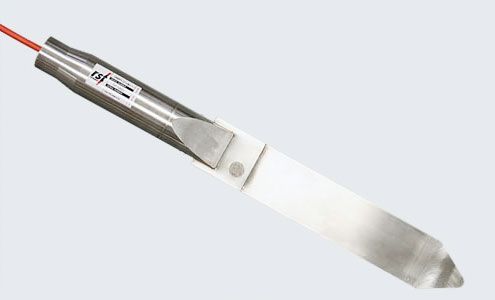PUSH-IN PRESSURE CELL

Overview
A Push-in Pressure Cell, also called Spade Cell, is designed to be pushed into the ground where it can measure total earth pressure and pore water pressure within the soil. It can be used as a site investigation tool to determine the in situ stress state, both vertical and horizontal, depending on the direction of installation. In addition, it can be used to monitor the change in active and passive pressure around retaining structures (diaphragm walls,…) as well as in tunneling, and other earthworks. Typical installations are in fine grained cohesive soils, including very soft to stiff clays.
Construction consists of two longitudinal stainless steel plates welded together around their periphery. The annular space between these plates is filled with deaired glycol. A port and filter for pore water pressure measurement are located on one of the flat sides of the support plate behind the pressure sensitive section of the cell.
The pressure cell and the port for the pore water pressure are connected via stainless steel tubes to two pressure transducers integrated in the cell, typically vibrating wire, or pneumatic, or strain gaged if dynamic measurements are to be performed. A thermistor for temperature measurement is also incorporated in the cell.
The installation method consists generally in drilling a pilot hole slightly shorter than the planned installation depth, and then to push the pressure cell about 1 meter past the bottom of the pilot hole using standard drill rods or CPT rods that will be left in place or retrieved at a later stage after measurements are completed. Push rods and a push adapter or an inverse thread adapter on the cell can also be used if the cell is to be pushed and left permanently in place with retrieval of the push rods.

Applications
Site investigation tool for estimation of in situ horizontal stress.
Risk assessment of hydraulic fracture of clay cores or cut-off trenches in dams.
Stress change adjacent to retaining walls.
Measurement of vertical and horizontal stresses to monitor clay cliffs degradation.
Monitoring stress redistribution around tunnels in soils.
Measurement of earth pressure changes during and after blasting compaction.
Measurement of lateral total earth pressure due to vibro stone columns and strip foundation loading.

Features
Integrated pore pressure measurement.
Long term stability.
High accuracy and sensitivity.
Constant monitoring capability.
Ease of data logging.
Either vibrating wire, pneumatic, or strain gauge transducers.
Click Below to Download Data Sheet
Data Sheet
All Rights Reserved | Geonor, Inc.

